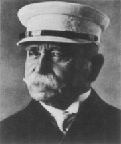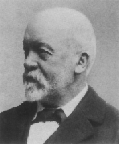|
|
Founders
|

|
Count Ferdinand Adolf August Heinrich Zeppelin
b. 8 July 1838, Constance, Baden
d. 8 March 1917, Charlottenburg, near Berlin
Count Zeppelin was persistent and indefatigueable in his pursuit
of his goal to construct a dirigible for Germany. He flew his
first airship -- the LZ1 -- over Lake Constance on 2 July 1900.
LZ1 was about 128 meters (420 feet) long and 38 ft in diameter.
Inside was a row of 17 gas cells each covered in rubberized cloth.
The hydrogen-gas capacity totaled 11300 cubic meters (399,000
cubic feet).
By comparison, LZ129 Hindenburg had a volume of 217,000 cubic
meters and a length of 245 meters. It could carry 200 tons.
The cylindrical framework was covered with smooth surfaced cotton
cloth. The ship was steered by forward and aft rudders and driven
by two 15-hp Daimler internal-combustion engines, each rotating
two propellers. Passengers, crew, and engine were carried in two
aluminum gondolas suspended forward and aft. At its first
trial it carried five persons attaining an altitude of 1300 feet
and flew a distance of 3.75 miles in 17 minutes.
DATE: 14 March 1899
PATENT: 621195
TITLE: Navigable Balloon
|
|

|
Hugo Eckener
b. 10 August 1869, Flensburg, Prussia
d. 14 August 1954, Friedrichshafen
Eckener joined Count Zeppelin in developing the rigid airship,
helped train pilots, and popularized airship travel. He was amiable,
courageous, thoughtful, and a first-class pilot. He popularized
the use of Zeppelins as transoceanic passenger ships. In a demonstration
flight, he commanded the Graf Zeppelin -- LZ127 -- in a round-the-flight
in 1929!
|
|
|
Ludwig Durr
b. 1878
d. 1956
Durr was Chief Engineer for Count Zeppelin. He was responsible
for the overall designs and incremental improvements of the Zeppelins.
|
|

|
Daimler, Gottlieb (Wilhelm)
b. March 17, 1834, Schorndorf, Württemberg [Germany]
d. March 6, 1900, Cannstatt, near Stuttgart
German mechanical engineer who was a major figure in the early
history of the automotive industry.
Daimler studied engineering at the Stuttgart polytechnic
institute and then worked in various German engineering
firms, gaining experience with engines. In 1872 he became
technical director in the firm of Nikolaus A. Otto, the man
who had invented the four-stroke internal-combustion engine.
In 1882 Daimler and his coworker Wilhelm Maybach left Otto's
firm and started their own engine-building shop. They
patented one of the first successful high-speed
internal-combustion engines (1885) and developed a
carburetor that made possible the use of gasoline as fuel.
The two used their early gasoline engines on a bicycle
(1885; perhaps the first motorcycle in the world), a
four-wheeled (originally horse-drawn) carriage driven by a
one-cylinder engine (1886), and a boat (1887). The two men's
efforts culminated in a four-wheeled vehicle designed from
the start as an automobile (1889). This commercially
feasible vehicle had a framework of light tubing, a
rear-mounted engine, belt-driven wheels, and four speeds. In
1890 Daimler-Motoren-Gesellschaft was founded at Cannstatt,
and in 1899 the firm built the first Mercedes car.
|
|
|
Maybach, Wilhelm (b. Feb. 9, 1846, Heilbronn,
Württemberg [Germany]--d. Dec. 29, 1929,
Stuttgart, Ger.), German engineer and industrialist who was
the chief designer of the first Mercedes automobiles
(1900-01).
From 1883 Maybach was associated with Gottlieb Daimler in
developing efficient internal-combustion engines; their
first important product, a relatively light four-stroke
engine, was patented in 1885. In 1890 Daimler and Maybach
formed the Daimler-Motoren-Gesellschaft, in Cannstatt, to
manufacture automobiles; from 1895 Maybach was the firm's
technical director. His design for a carburetor was widely
used from 1893 and was the subject of litigation (successful
in England) over infringement of his patents. In 1909
Maybach and his son Carl organized a company at
Friedrichshafen to build aircraft engines, including the
power plants for airships constructed by the Zeppelin
organization, to which the Maybachs' firm was subsidiary.
Automobiles bearing the Maybach marque were produced from
1922 to 1939.
For the earliest Mercedes cars Maybach greatly improved
an existing design for a 24-horsepower engine, providing
mechanical inlet valves that could be throttled by the
driver. He was at least in part responsible for the
development of a light pressed-steel chassis with a
honeycomb radiator; the initial conception perhaps should be
credited to Paul Daimler, Gottlieb's son.
|
|